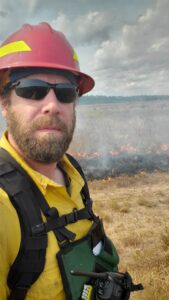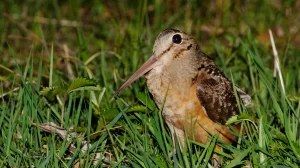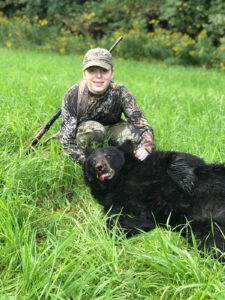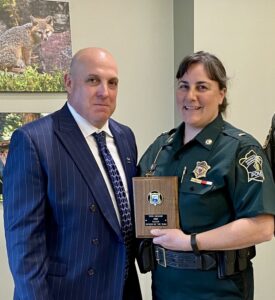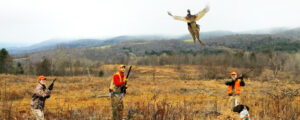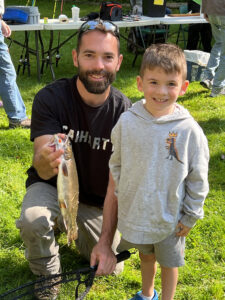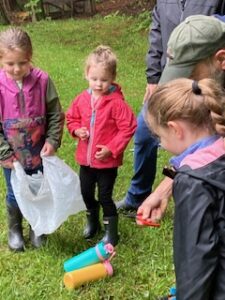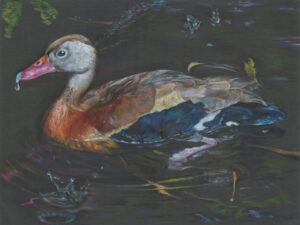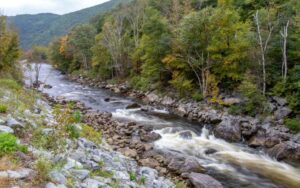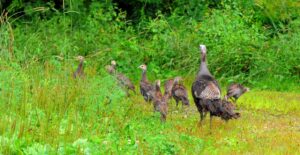MassWildlife holds a special three-day deer hunting season for paraplegic hunters. Staff and volunteers place hunters in safe areas at several hunt locations in the state. When a hunter shoots a deer, volunteers assist the hunter by retrieving the deer, field dressing it, and getting it checked in on site.
Each year, about 12-20 paraplegic hunters sign up for the special hunt. For Some of these people, it’s the only opportunity they have to hunt. The hunt is typically held at 5 sites:
- The Northern Berkshires on private properties
- The Southern Berkshires at Mt. Washington
- The Quabbin Reservation
- Devens Reserve Forces Training Area in Lancaster
- Otis/Edwards Military Reservation in Falmouth/Bourne
Frequently, hunters see deer and several get the opportunity to harvest a deer.
The dates of the 3-day hunt this year were November 2 to 4. Other than being a little chilly, the weather cooperated nicely. Statewide this year some 18 hunters participated, (3 at the Northern Berkshires site, 5 at the Southern Berkshires site, 5 at Quabbin, 1 at Fort Devens, and 4 at Joint Base Cape Cod).
Statewide, a total of 10 deer were harvested during the 3-day hunt. Only one deer, a doe, was harvested here in the Berkshires, that being in the Southern Berkshires, although all the Berkshires hunters saw deer.
Two does were harvested at the Quabbin Reservation, both of which were taken by hunters who were new to the special program this year, and the remaining Quabbin hunters all saw deer. Three deer, a doe, a 4-point buck and an 8-point buck were harvested by the hunter at Devens. At Otis/Edwards Military Reservation, one adult buck without antlers, a 4-point buck, and two does were harvested by two of the four hunters while the other two hunters saw deer and had shooting opportunities.
In the Southern Berkshires, hunters Marc Tartaglia of Barkhamsted, CT, Dan Massaconi of Cheshire, MA, Sidney Eichstedt of Lee, MA, Vito Vyto Sablevicius of Norwood, MA and Timothy Davidson of West Stockbridge, MA participated.
Marc Tartaglia got the only deer, a doe. (He got a doe and a buck at last year’s hunt). On Friday afternoon, he also took a shot at a deer, but it got away. Dan Massaconi came this year with a new shotgun and was eager to get his first deer with it. While he did not harvest any deer this year, Dan did see quite a few does Saturday afternoon/evening. 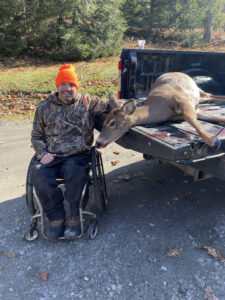
Timothy Davidson, of West Stockbridge hunted Thursday and Friday evening assisted by his son-in-law Rich Bravman and they saw a pack of six coyotes Thursday afternoon.
Each morning the volunteers helped the hunters get to their deer stands, and around noon they brought them in to the DCR Headquarters in Mount Washington and provided them with a warm, home cooked meal prepared by Wendy Lampro. When I was there on Friday, she had cooked up delicious venison chili, stew and back straps, pork chops, mac and cheese and a tasty dessert. Her future son-in-law, Dallas Tidwell, grilled some tasty venison burgers.
Southern Berkshire volunteers and their years of involvement are as follows: Shaun Smith – 49 years, Marc Portieri – 34, Gregg Arienti – 28, Paul Mullins 28, Matt Roche (DCR) – 16, Fred Lampro – 14, Thomas Dean – 12, Casey Green –3, Dan White – 2, Christel Massaconi –3, Dallas Tidwell – 2, James Dellea – 2, Wendy Lampro – 2, Shamus Daley – 1 and Rich Bravman.
MassWildlife Western District Supervisor Andrew Madden was there, as was Wildlife Biologist Nate Buckhout in case any deer needed tagging. Also, Dan White and Travis Clairmont from the Department of Conservation and Recreation (DCR) were there as were MA Environmental Police Officers Phil Smitts and Nick Stone.
Special thanks go out to Cobb of Western Mass, Klan-Cook family, Cobb of River Valley, Shaw Pond Club, Chaffee Construction, Lee Fire Dept., Bossidy-Crerar VFW Post 893 in Lee, James Leahey Excavating of Lee, AMVETS Post 77 and Osden’s Plumbing and Heating of Blandford.
Special thanks also go to the DCR for providing the space to gather, eat, and warm up at Mt. Washington Reservation.
In the Northern Berkshires, hunters Shawn Mei of Baldwinville, MA, Dale Bailey of Clarksburg, MA and Dave Alderman of Petersburg, NY participated.
All of them saw deer but none were harvested.
The volunteers brought the hunters to a central point at lunchtime and provided them with a delicious meal of moose stew cooked up by Ruth French. I had a bowl of that stew and it was delicious. (It is no coincidence that I visit these places around lunch time).
Northern Berkshire volunteers and their years of involvement are as follows: Rick French – 37 years, Tony Mei – 33, Stacy Sylvester – 35, J. Sylvester – 25, Jim Guiden, Alex Dargie and Joe Benoni. Sorry, I don’t have the number of years for all of the volunteers. J. Sylvester came all the way from Maine to volunteer for the hunt.
Special thanks go out to Jim Guiden for providing the headquarters space and to the Cricket Creek Farm for permitted hunting on their property.
Western District MassWildlife staff covering the Northern site location were Ray Bressette, Eli Pease, and Jacob Morris-Siegel. EPOs Lt. Tara Carlow and Officer Jonathan Kolis periodically stopped in.
According to MassWildlife Biologist and state-wide coordinator of this hunt, Susan McCarthy, deer were seen by all participants and feedback was positive from everyone, particularly hunters who were new to the program.
According to McCarthy, total statewide, there were 12 MassWildlife employees, 5 MA Environmental Police Officers, 7 DCR staff members, 6 private landowners, 4 military personnel, and 30 volunteers totaling 64 individuals aside from hunters and their family members supporting the program and assisting hunters.
As noted in the past, this story is not all about the hunters and their harvests. There are other components which must occur to make the hunt a success. One is the volunteering. As noted, statewide there were 30 volunteers assisting in helping the physically challenged hunters get to ideal hunting spots and who helped them by getting the deer moving, retrieving the deer, field dressing them, and getting them checked in on site.
McCarthy noted that, “As always, this hunt would not be possible without our fantastic network of MassWildlife and DCR staff, private landowners in the Berkshires, and our amazing volunteers.”
Without Sue McCarthy’s, Andrew Madden’s, Fred and Wendy Lampro’s, and Rick French’s help, the information in this column simply could not be obtained. Thank you.
In the earlier years of this program, there were many more participants, but in later years the numbers have dwindled. Suggestions have been made to bolster the numbers which I hope to get into in a future column.
Incidentally, paraplegic sportsmen and women interested in taking part in the hunt next year should contact Susan McCarthy at (508) 389-6326.
No, they’re not boasting off
About this time of year, I receive comments chastising the deer hunters for overtly displaying their deer while transporting them. Some hunters even go to the trouble of displaying parts of the deer outside their car trunks or sticking up over the truck tailgates. Terrible things for the children to see, they say.
Well, the regulations require that part of the deer needs to be displayed prior to it being reported/checked in. If they didn’t, they could be cited. Once the hunter has checked it in, then there’s no need to have it open to view. Page 29 of the hunting and fishing abstracts (laws) spells it out. One year I transported my deer in the open bed of my pickup truck to check it in at the DFW deer check station in Dalton. An EPO there told me that I should have had a leg or some part of the deer raised over the closed tailgate making it easier to view.

